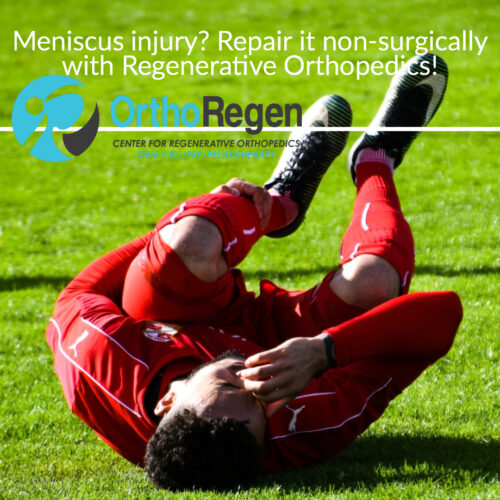Meniscus tears of the knee and labral tears of the hip commonly occur from some form of trauma. Sporting events and activities are common culprits. The tears are not always immediate, but can arise after another structure of the hip or knee is damaged.
Injury or damage to the joint inhibits normal functioning. And with continual use and wear and tear, the bones in the joint will rub against each other abnormally. Oftentimes, the injury of ligaments, tendons and the meniscus or labrum make the joint unstable and painful. As this course continues, the knee or hip joint will degenerate and progress to arthritis.

Meniscus Tears Can Be Repaired Non-Surgically
The menisci protect the cartilage in the knee from high stresses placed upon the joint. They are located between the femur and the tibia bones. Injury to the meniscus is one of the most common knee injuries for which people seek medical care.
Surgery is frequently recommended for various types of meniscus tears. Types of meniscus tears include bucket handle tears, radial tears, horizontal tears, and oblique tears. When more than one of these patterns is present, the tear is called a complex tear. Surgery is frequently recommended for these tears. But surgery, including arthroscopic surgery, adds to the instability of the joint. Why? Because during the surgery joint structures are cut, scraped and removed.
The meniscus and the articular cartilage are the most commonly removed structures, when arthroscopic surgery of the knee is performed. When the meniscus and cartilage are removed, the femur bone is unable to glide smoothly over the tibia. This enhances knee instability and hastens the arthritic rate. It changes the dynamics within the joint causing abnormal knee joint function.
Arthroscopic surgery boosts arthritic degeneration, because pressure on the cartilage escalates when the meniscus is removed, and the joint becomes more unstable with the stretching, cutting and scraping of the ligaments, tendons and cartilage. The degeneration of the articular cartilage appears to be proportional to the size of the segment removed. The joint breakdown leads to further thinning of the remaining articular cartilage. This allows for increased pressure on the underlying tibia bone which then increases pressure on the ligaments.
When the ligaments tear, the instability becomes even worse. The result of this breakdown of the joint is a cycle of knee pain, joint degeneration, structure damage, and even more pain.

Treat Labral Tears Effectively with Regenerative Orthopedics
The hip labrum, along with various hip ligaments and the normal deep socket configuration of the anatomy of the hip joint, provide most of the stability of the hip
Injury to the ligaments, tendons and labrum, initiate the same damage and pain cycle that we described for the knee, which results in ongoing hip pain and can lead to hip arthritis. Surgical repair of the hip labrum and hip replacement are needed at times, but in our opinion, should be sought as a last resort.Tr
Just as removal of the meniscus increases instability in the knee, extraction of the labrum makes the hip joint more unstable, and will eventually degenerate the hip and lead to further arthritis.
Non-surgical options do exist to treat both meniscal and labral tears.
Regenerative Orthopedics, a regenerative injection therapy, has been successfully utilized to repair and regenerate the injured ligaments, tendons, meniscus, labrum and cartilage in injured and degenerated knee and hip joints. The therapy boosts collagen formation both outside and inside the knee and hip joint, by stimulating the body to repair itself.
Comprehensively treating all of the ligament attachments of the joint, ensures the stability of the hip and knee joint, since treating the ligaments tightens the loose supporting structures, aiding in the elimination of pain. In cases of advanced degeneration and arthritis, the Gold Standard in Stem Cell Therapy can be utilized, which incorporates bone marrow stem cells, as well as adipose stem cells, plus Platelet Rich Plasma (PRP), and Prolotherapy in a combined regenerative procedure.
Stem cells can self-renew and differentiate (or change) into a variety of cell types, and repair injured tissue. PRP and Prolotherapy activate growth factors which augment stem cell proliferation and aid in the repair of conditions with cellular deficiencies, like a damaged meniscus or labrum. The Gold Standard in Stem Cell Therapy provides the cells and growth factors that the damaged tissues and degenerative conditions lack, to aid in their healing.
Most painful joint conditions begin with joint instability due to damage to the surrounding ligaments. The instability can progress to meniscal injuries or labral degeneration and eventually to knee or hip arthritis. Treatments such as arthroscopy to repair these tears can actually increase the arthritic process.